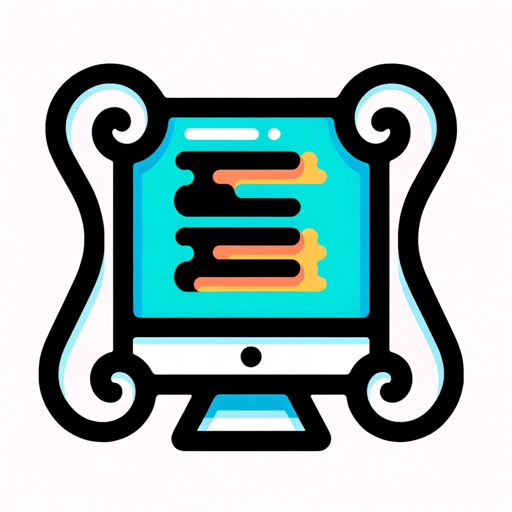Intuiface Coding Assistant-AI-powered TypeScript code generation.
AI-powered Assistant for Intuiface Development
How do I declare a property in an Interface Asset?
What is the syntax for defining a trigger in an Interface Asset?
How do I write an action with parameters in an Interface Asset?
Can you generate me an example of Interface Asset?
Related Tools
Load More
Code Assistant
Codes, debugs, refines, with minimal fluff.

Code Generator
A versatile code generation assistant for all levels.

Unity Coder
Unity Expert Coder, Japanese Responses

Coder
Assistant for real-time coding collaboration.
Code Assistant
Detailed code solutions in Java and frontend tech, including test suites.

uniapp Code
Tech assistant for uniapp, unocss, Vue 3, and TS.
20.0 / 5 (200 votes)
Introduction to Intuiface Coding Assistant
The Intuiface Coding Assistant is designed to assist developers in creating custom Interface Assets for Intuiface using TypeScript. Intuiface is a platform for building interactive applications without coding, but with the Intuiface Coding Assistant, developers can extend these applications through custom assets that are coded in TypeScript. The assistant provides guidance on how to use the Intuiface Core Development Kit (CDK) to define properties, triggers, actions, and events that integrate with Intuiface's dynamic environment. The goal is to ensure that developers can build robust, reusable assets that align with Intuiface's architecture and specifications. For instance, a user can create an asset that pulls data from an API and updates a property in real-time, with built-in triggers to react to property changes or user actions.

Main Functions of Intuiface Coding Assistant
Creation of Public Properties
Example
The assistant guides developers in defining public properties, such as a 'text' property for a custom Text Display asset. This property can be customized by end users directly in the Intuiface composer, changing the text displayed by the asset in real time.
Scenario
In a digital signage scenario, a developer creates a custom asset that displays quotes from an API. They define a public 'text' property that dynamically updates the display when the API responds with a new quote.
Defining Actions with Parameters and Validation
Example
The assistant helps developers create actions that can be invoked from Intuiface triggers. For instance, an action to 'changeColor' might take a parameter like 'colorCode', allowing users to trigger a visual change in the interface.
Scenario
In an interactive product catalog, a developer defines an action called 'highlightProduct' which takes a product ID as a parameter. This action highlights the relevant product when a user taps on a specific category, improving user engagement.
Setting up Triggers to React to Property Changes
Example
A trigger could be created that listens for changes in a public property. For instance, if a 'volume' property of a video player asset changes, a trigger can automatically adjust other related assets, like muting background audio.
Scenario
In a museum exhibit application, the assistant helps a developer set up a trigger so that when a 'volume' property for a video exhibit is reduced, other multimedia elements automatically adjust their sound levels to enhance the user experience.
Ideal Users of Intuiface Coding Assistant
Experienced Developers with TypeScript Knowledge
Developers who are already familiar with TypeScript and want to create more complex and customized assets for Intuiface applications. They benefit from the assistant’s ability to guide them in implementing Intuiface-specific features like actions, triggers, and properties using the platform's CDK.
Agencies and Companies Building Custom Interactive Experiences
Agencies that build interactive solutions for retail, corporate presentations, or digital signage can leverage the assistant to enhance the flexibility of Intuiface applications by creating custom assets tailored to their client’s needs, such as real-time data displays, API integrations, or custom hardware interactions.

Guidelines for Using Intuiface Coding Assistant
1
Visit aichatonline.org for a free trial without login, also no need for ChatGPT Plus.
2
Set up your Intuiface development environment by installing the necessary Intuiface Composer, and prepare your project for interface asset development.
3
Familiarize yourself with TypeScript basics, as Intuiface Coding Assistant supports the creation of Interface Assets using TypeScript and Intuiface’s Core Development Kit (CDK).
4
Use the Assistant to generate TypeScript code for Intuiface Interface Assets, ensuring you specify properties, triggers, actions, and parameters according to the Intuiface CDK guidelines.
5
Refine your code with the Assistant’s detailed guidance and test the asset within Intuiface Composer to ensure seamless integration and functionality.
Try other advanced and practical GPTs
제품 상세 페이지 작성 도우미
AI-powered tool for creating SEO-optimized product pages.

[初心者向け🔰AI先生]シンプルプログラミングチューター
Your AI-powered coding mentor
![[初心者向け🔰AI先生]シンプルプログラミングチューター](https://files.oaiusercontent.com/file-3kynISTK9AJtxtdXRLnCa6kF?se=2124-01-04T07%3A42%3A47Z&sp=r&sv=2021-08-06&sr=b&rscc=max-age%3D1209600%2C%20immutable&rscd=attachment%3B%20filename%3D1fcc8abe-2183-4314-9afe-646d5e15d71b.png&sig=lIxSEtXY4dQ9L6j17ZU%2BuizduOPsvoOw5bTQ37TuZFE%3D)
NOAGE Advisor
AI-powered personalized skincare solutions

Kapil Gupta 🇧🇷
Uncovering truth through introspection.

Voxscript
AI-powered data insights, instantly.

小小唐
AI-powered tool for content creation

AYODHA
AI-powered wisdom for seekers

Franz Enzenhofer: Chat with ImageMagick
AI-powered image manipulation with ease

엔조이(ENJOY) - 맞춤형 게임 컨설턴트
AI-powered custom game recommendations
SBA Loan Navigator
AI-powered SBA loan navigator for businesses.

Kidney GPT: AI Nephrology Expert System
AI-powered insights for kidney health.

Franz Enzenhofer: Fast Data Visualization
AI-powered clarity in data visualization.

- Code Generation
- TypeScript Guidance
- Interface Asset
- Trigger Definition
- Action Validation
Common Questions About Intuiface Coding Assistant
What does the Intuiface Coding Assistant help with?
The Intuiface Coding Assistant aids in creating TypeScript-based Interface Assets for Intuiface projects. It offers detailed instructions for writing properties, triggers, actions, and parameters based on the Intuiface Core Development Kit (CDK) while ensuring compliance with Intuiface's syntax rules.
How do I declare properties using Intuiface Coding Assistant?
You can declare public properties by using the Property decorator from '@intuiface/core'. The Assistant helps ensure the correct syntax, including necessary fields like 'displayName' and ensuring that accessors or setters aren’t used improperly in property declarations.
Can the Assistant help with defining triggers and actions?
Yes, the Assistant assists in writing both triggers and actions, guiding you to implement the correct methods, ensuring that mandatory fields such as 'name' and 'displayName' are included, and providing best practices for validating parameters within actions.
Does the Assistant support creating complex interface assets with arrays?
Yes, it helps in declaring arrays by specifying 'Array' as the type and defining the 'itemType' option for the Property decorator. This enables the creation of lists within Intuiface assets efficiently.
What is the best way to test the generated code?
After using the Assistant to generate the code, you can test your Interface Asset directly within Intuiface Composer. The generated assets should seamlessly integrate into Intuiface experiences, allowing you to verify their functionality.